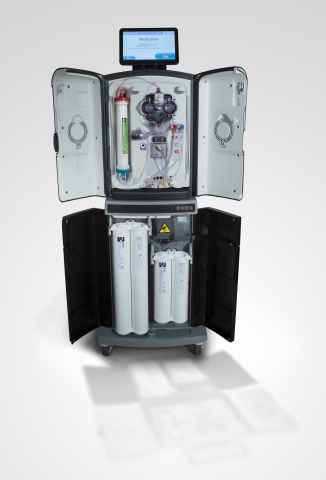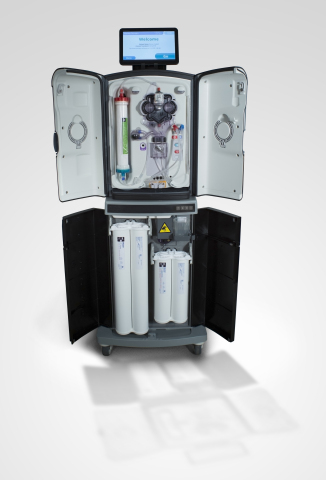AMSTERDAM--(BUSINESS WIRE)--Baxter International Inc. (NYSE:BAX) today announced the presentation of clinical data supporting the safety and efficacy of the VIVIA haemodialysis (HD) system. Results from two studies conducted in a clinical setting showed acceptable clearance of uremic toxins and an overall safety profile similar to that associated with conventional HD devices. The VIVIA system, designed to deliver High Dose HD in the home, completed the CE marking process (market approval) in Europe, December 2013.
These data for the VIVIA HD system were shared for the first time with the European nephrology community at the 51st Congress of the European Renal Association and European Dialysis and Transplant Association (ERA-EDTA), May 31 to June 3 in Amsterdam.
''We conducted the studies to evaluate the efficacy and safety of the VIVIA HD system, which demonstrated its ability to provide acceptable clearance of uremic toxins, safely and reliably,'' said Bruce Culleton, M.D., vice president, renal therapeutic area lead, Baxter. ''This research, in combination with the VIVIA HD system’s patient-friendly design features, may allow a greater number of dialysis patients suited for home HD to access High Dose HD therapy in the home environment.''
VIVIA Clinical Studies
The first in-human study was a prospective, single arm clinical study (Abstract #SP415) conducted in haemodialysis centres in the United States, in which 22 patients received four HD treatments with the VIVIA HD system every week for 10 weeks. The mean duration of each HD treatment was 3.8 hours. A mean weekly standard measure of urea clearance (Kt/Vurea) and dialysis adequacy, was 2.97. No device-related serious adverse events occurred during the study. The feasibility of multiple use of the same dialyser on the same patient was also established.
In a second prospective, single arm clinical study (Abstract #SP431) conducted in haemodialysis centres in Canada, 17 patients received nocturnal HD treatments with the VIVIA HD system three times per week, for six weeks. The mean duration of nocturnal HD treatment was 7.0 hours. The feasibility of multiple use of the same dialyser on the same patient during long HD treatments was also established. No device-related serious adverse events occurred during the study. Both studies provided support of the VIVIA HD system’s capability to accurately remove excess body fluid, as shown by the strong correlation between fluid weight removed, as measured by the VIVIA HD system, and weight change (R2 0.97 in both studies).
A More Sustainable Therapy
Additional data presented at the congress support non-clinical advantages for High Dose HD performed in the home, including a study demonstrating the VIVIA HD system had a smaller carbon footprint compared to a currently-available home HD device and to a conventional in-centre HD device that can be used for home dialysis (Abstract #SP440). The study used the life cycle assessment method to calculate emissions including consumable supplies, energy and water used during treatment, people transportation and waste disposal. Due in part to multiple uses of its dialyser and blood set, the VIVIA HD system generated the lowest amount of carbon emissions. These results suggest optimizing the use of consumables will have a significant impact in delivering sustainable HD therapies.
The VIVIA HD system is being introduced on a limited basis in select European dialysis clinics in 2014 to allow patients and healthcare providers experience with the system and its patient-friendly features.
A More Cost-Effective Therapy
Other studies included analyses on cost effectiveness and cost savings attributable to High Dose HD at home. A review of the scientific literature found High Dose HD at home to be either cost saving or cost effective compared to conventional in-centre HD, while High Dose in-centre was not cost effective (Abstract #MP562). Two separate analyses of High Dose HD in the U.K. demonstrated that increased usage could lead to potential cost savings (Abstract #SP615) and an increase in quality-adjusted, life-years gained (Abstract #SP607).
ERA-EDTA presentations may be available on the congress website following the conclusion of the meeting. For more information, log on to era-edta2014.era-edta.org.
About High Dose HD
An estimated 1.9 million end-stage renal disease (ESRD) patients worldwide undergo haemodialysis, with the vast majority receiving conventional haemodialysis (CHD), which is usually performed three times a week for three to five hours per session in a centre or clinic1.
High Dose HD therapy is a more frequent therapy usually performed as short daily treatments at least five days per week for sessions that typically run less than four hours, or as nocturnal treatments where sessions are conducted for greater than six hours while the patient sleeps with no consecutive days off from therapy2. High Dose HD therapy has been associated with improvements in survival and clinically important health measures, including health-related quality of life, compared with CHD3,4,5,6 .
About Baxter
Baxter International Inc., through its subsidiaries, develops, manufactures and markets products that save and sustain the lives of people with hemophilia, immune disorders, cancer, infectious diseases, kidney disease, trauma and other chronic and acute medical conditions. As a global, diversified healthcare company, Baxter applies a unique combination of expertise in medical devices, pharmaceuticals and biotechnology to create products that advance patient care worldwide.
This release includes forward-looking statements concerning Baxter’s VIVIA HD system, including expectations regarding the planned launch of VIVIA and its use by patients. The statements are based on assumptions about many important factors, including the following, which could cause actual results to differ materially from those in the forward-looking statements: actions of regulatory bodies and other governmental authorities; satisfaction of regulatory and other requirements; product quality or patient safety issues; changes in laws and regulations; and other risks identified in Baxter's most recent filing on Form 10-K and other SEC filings, all of which are available on Baxter's website. Baxter does not undertake to update its forward-looking statements.
Baxter and VIVIA are trademarks of Baxter International Inc.
_______________________
1 Anand S, Bitton A, Gaziano T (2013) The Gap between Estimated Incidence of End-Stage Renal Disease and Use of Therapy. PLoS ONE 8(8): e72860. doi: 10.1371/journal.pone.0072860.
2 Honkanen E, Hazel I, Zimmerman D. High-dose hemodialysis: time for a change. Hemodial Int. 2014;18:3-6
3 Pauly RP, Gill JS, Rose CL, et al. Survival among nocturnal home haemodialysis patients compared to kidney transplant recipients. Nephrol Dial Transplant. 2009;24(9):2915-2919.
4 Chertow GM, Levin NW, Beck GJ; FHN Trial Group. In-center hemodialysis six times per week versus three times per week. N Engl J Med. 2010;363(24):2287-2300.
5 Nesrallah GE, Lindsay RM, Cuerden MS, et al. Intensive hemodialysis associates with improved survival compared with conventional hemodialysis. J AM Soc Neprol. 2012 April; 23(4): 696–705. doi: 10.1681/ASN.2011070676
6 Culleton B, et al. Effect of frequent nocturnal hemodialysis vs conventional hemodialysis on left ventricular mass and quality of life. JAMA 2007; 298 (11) 1291-1299.




